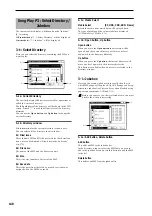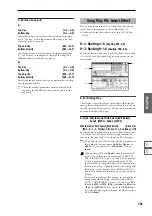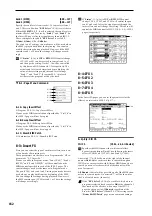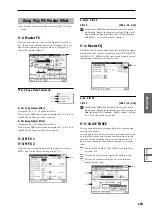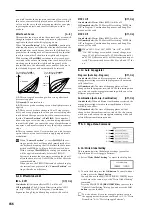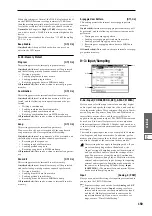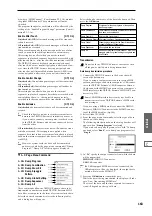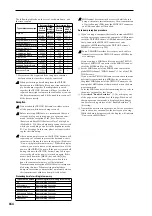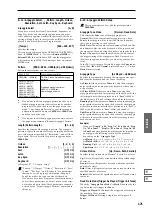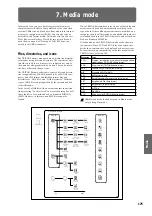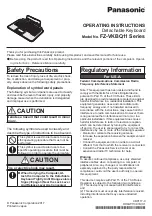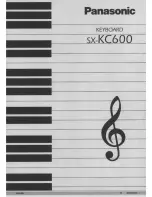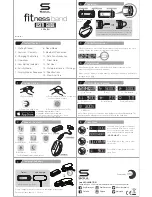
162
sequencer. MIDI data received from MIDI IN or the data
played back by the internal sequencer will not be affected.
PostMIDI:
Velocity Curve, After Touch Curve, and Trans-
pose will be applied to data before it enters the tone genera-
tor.
This means that the Velocity Curve, After Touch Curve, and
Transpose settings will affect the data that is sent to the
internal tone generator when you play the TRITON
Extreme’s keyboard, when the internal sequencer is played
back, or when data is received from MIDI IN.
This setting will not affect the data that is transmitted from
MIDI OUT or recorded on the internal sequencer when you
play the TRITON Extreme’s keyboard or playback the
sequencer.
MIDI Clock (MIDI Clock Source)
[Internal, External MIDI, External USB]
Sets this parameter when you wish to synchronize an exter-
nal MIDI device (sequencer or rhythm machine etc.) with
the TRITON Extreme’s internal arpeggiator or sequencer.
Internal:
The internal arpeggiator and sequencer will syn-
chronize to the TRITON Extreme’s own internal clock.
Select the Internal setting when using the TRITON Extreme
by itself, or when you want the TRITON Extreme to be the
master
(controlling device) so that another connected exter-
nal MIDI device will synchronize to the MIDI Clock mes-
sages transmitted from the TRITON Extreme.
External MIDI:
The arpeggiator and sequencer of the TRI-
TON Extreme will synchronize to MIDI Clock messages
transmitted from an external MIDI device connected to the
MIDI IN connector.
External USB:
The TRITON Extreme will synchronize to the
MIDI Clock messages transmitted by an external MIDI
device connected to the USB B connector, and the internal
arpeggiator and internal sequencer of the TRITON Extreme
will operate as a slave device.
If you want the TRITON Extreme to function as a slave (the
device that is controlled) so that it synchronizes to the MIDI
Clock transmitted from an external MIDI device, set this
parameter to either External MIDI or External USB. The
TRITON Extreme will respond to MIDI Common messages
and Realtime messages (Song Position Pointer, Song
SELECT, Start, Continue, and Stop) from an external
sequencer.
In Song Play mode, the TRITON Extreme will operate
in synchronization with its own internal clock regard-
less of this setting.
Receive Ext. Realtime Commands
[Off, On]
Off (unchecked):
When “MIDI Clock” is set to External
MIDI
or External USB, MIDI Common messages and Real-
time messages (Song Position Pointer, Start, Continue, and
Stop) will not be received. (Song Select will be received.)
Use this setting if receiving these messages from an
external MIDI sequencer would cause the song settings
of the TRITON Extreme to be unwantedly reset.
On (checked):
The above Common messages (including
Song Select) and Realtime messages will be received.
This parameter cannot be set if “MIDI Clock” is Inter-
nal
.
1–1b: MIDI Filter
Enable Program Change
[Off, On]
On (checked):
Program changes will be transmitted and
received.
In Program mode (P0: Play), the program will be switched
when a program change message is received on the global
MIDI channel specified by “MIDI Channel” (1–1a). When
you switch programs, a program change message will be
transmitted on the global MIDI channel.
In Combination mode (P0: Play), the combination will be
switched when a program change message is received on
the global MIDI channel. However, it is possible to set the
“Enable Combination Change” parameter so that the combi-
nation is not switched. When a program change is received
on the channel specified for each timbre by “MIDI Channel”
(Combination P2: 2–1b), the program of that timbre will be
switched. However, the program changes for each timbre
will be affected by the setting of the “Enable Program
Change” parameter (Combination P3: 3–1a).
When you switch combinations, a program change message
will be transmitted on the global MIDI channel, and also
transmitted simultaneously on the channel of timbres whose
“Status” (Combination P0: 0–1c, 2–1b) is set to EXT or EX2.
In Sequencer mode, incoming program change messages on
a channel that corresponds to a track whose “Status”
(Sequencer P2: 2–1a/2a) is set to INT or BTH will switch
programs on that track. When you select a song or playback
sequencer data, program changes will be transmitted on the
channels of tracks whose “Status” is set to BTH, EXT, or EX2.
Off (unchecked):
Program changes will not be transmitted
or received.
Enable Bank Change
[Off, On]
On (checked):
The Bank Select control change message will
be transmitted together with program change messages.
This is valid when “Enable Program Change” is checked.
Off (unchecked):
Bank Select messages will not be transmit-
ted or received.
When recording on the internal sequencer, bank select
messages will be recorded regardless of this setting.
However for playback, this setting will apply.
Enable Combination Change
[Off, On]
On (checked):
When in Combination P0: Play, an incoming
program change message on the global MIDI channel set by
“MIDI Channel” (1–1a) will switch combinations. This is
valid when “Enable Program Change” is checked. An
incoming program change on a channel other than the glo-
bal MIDI channel will switch the program of any timbre that
matches that MIDI channel.
Off (unchecked):
An incoming program change message on
the global MIDI channel will switch the program of any tim-
Velocity
Curve
Aftertouch
Curve
Tone
generator
Note number
change
Play
MIDI IN
MIDI OUT
Record
Sequencer
Transpose
Scale
Velocity
Curve
Aftertouch
Curve
Tone
generator
Play
MIDI IN
MIDI OUT
Record
Sequencer
Transpose
Scale
Pitch change
Summary of Contents for TRITON Extreme
Page 1: ...2 E ...
Page 11: ...xii ...
Page 111: ...100 9 5 Page Menu Command 0 1A 0 1I 0 1J Program 9 5A ...
Page 185: ...174 ...
Page 215: ...204 ...
Page 281: ...270 ...
Page 349: ...338 ...
Page 350: ...339 ...
Page 351: ...340 ...
Page 352: ...341 ...
Page 353: ...342 ...

